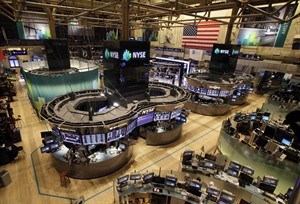
U.S. markets set for declines as world markets plunge on bad Chinese data
TORONTO – North American markets were poised for more declines Thursday after Japan’s Nikkei index plunged amid disappointing Chinese manufacturing data and talk that the U.S. Fed plans to end its extraordinary stimulus program in the future.
The Nikkei fell 7.3 per cent to 14,483.93 — its largest slide since Japan was hit by a devastating tsunami more than two years ago. The drop was also partly blamed on a spike in Japanese government bond yields.
The Nikkei has been the best-performing major index this year, having risen around 45 per cent — before Thursday’s loss — to five-year highs. The index has been buoyed by the announcement of an aggressive monetary stimulus from the Bank of Japan, which has piled the pressure on the yen.
That development is a potential boon to the country’s exporters and therefore to growth — a favourable backdrop for stock investors.
On Wall Street, the Dow Jones industrial futures fell 116 points to 15,204, the S&P 500 futures index dipped 15.20 points to 1,640.40, while the Nasdaq futures drifted lower by 27.75 points to 2,973.25.
The Canadian dollar was slightly ahead by 0.28 of a cent to 96.67 cents US.
On Wednesday, Fed chairman Ben Bernanke sent mixed messages about the central bank’s plans for a stimulus program that buys back $85-billion of bonds per month.
In prepared remarks to the U.S. Congress, Bernanke said the Fed has no plans of ending the monetary stimulus, but when pressed, he said the Fed would consider stopping the program once the economy shows significant signs of improvement — which could be as early as U.S. Labor Day in September.
Minutes of the Fed’s last monetary meeting from April 30-May 1, released following Bernanke’s speech, showed that some officials had considered slowing down the asset purchases as early as June.
Much of the recovery in global stock markets over the past few years has had its roots on the extra liquidity that’s flown through financial markets as a number of central banks, particularly the Fed, have pursued stimulus programs.
The withdrawal of this new liquidity has, for some time, been viewed as the greatest threat to stocks in particular.
Meanwhile, investors will be turning to the latest housing data for the U.S.
Analysts expected sales of new single-family homes to rise from 417,000 in March. While the Federal Housing Finance Agency will also reveal its home-price report for March.
In corporate news, earnings season for Canada’s major banks began with TD Bank Group (TSX:TD).
The bank reported before markets opened that it had a “solid” second quarter, with growth in most of its major sectors, but came up short of analyst estimates. Its net income was up two per cent from a year ago $1.723 billion or $1.78 per share while its adjusted earnings were $1.8 billion, or $1.90 per common share.
While the adjusted earnings were up six per cent from a year ago, they were just short of a consensus estimate of $1.91 per share compiled by Thomson Reuters. Net income, which is less closely watched by analysts, also missed.
Elsewhere in the world, London’s FTSE 100 index of leading British shares, which was only around 75 points off its highest-ever close on Wednesday, was down 1.9 per cent at 6,710. Germany’s DAX, which has hit a series of all-time highs recently, tumbled 2.6 per cent to 8,306 while the CAC-40 in France was 2.3 per cent lower at 3,956.
Asian markets sank sharply after a survey showed China’s manufacturing contracted in May.
HSBC said its preliminary Purchasing Managers Index fell to a seven-month low of 49.6 in May from April’s 50.4. Numbers below 50 indicate that activity is contracting. Analysts had expected a more modest decline to 50.3.
The Shanghai Composite Index lost 1.2 per cent to 2275.67, its biggest fall in a month while the smaller Shenzhen Composite Index shed 0.7 per cent to close at 1014.47.
Hong Kong’s Hang Seng slumped 2.5 per cent to 22,669.68. South Korea’s Kospi lost 1.2 per cent to 1,969.19. Australia’s S&P/ASX 200 dropped 2 per cent to 5,062.40.
On the commodities front, June gold bullion surged ahead $25.90 to US$1,393.30 an ounce,
The July crude contract was down $1.35 to US$92.93 a barrel and July copper fell 10 cents to US$3.28 a pound.
Join the Conversation!
Want to share your thoughts, add context, or connect with others in your community? Create a free account to comment on stories, ask questions, and join meaningful discussions on our new site.




















Leave a Reply
You must be logged in to post a comment.